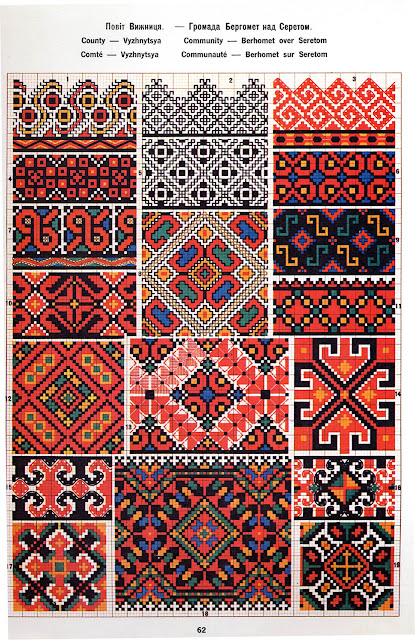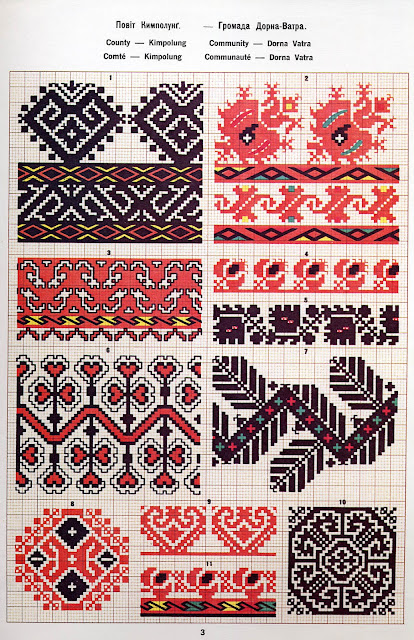

Hello all,
I recently received a request as to how to tell the difference between Ukrainian Bukovyna embroidery and Romanian Bucovina embroidery. There is no straightforward answer. In the local communities, the people know which village is inhabited by which ethnicity, and they could tell you, but there are no overarching rules which always apply. Nevertheless, there are regional differences, and some of these regions are overwhelmingly of one nationality or the other, only the central region being mixed. Kolbenheier was an Austrian who traveled in Bukovyna before the fall of the empire, and recorded some designs from various regions. He made a notation of the ethnicity of each local community. I have the reprint which was done in the 1970's by the Ukrainian Women's Association of Canada, which omitted that information. Nonetheless, I will sort his prints here for you by region. There is a notable difference in style, and some can be difinitively attributed to one nation or the other. Above you see a map which shows the ethnic composition and distribution of Bukovyna under the Austrians. Ukrainians are shown in black, Romanians in white, and other ethnicities in various cross hatching. The present border crosses this region from west to east at about the center.
Here is a modern map of the same area.
I personally divide Bukovyna-Bucovina into four zones, each of which has a recognizable embroidery style.
I. Western zone.
This is inhabited by Hutsuls, who are Ukrainian. This consists of the counties of Vyzhnytsia, and the western parts of Radiwtsi and Câmpulung Moldovenesc counties. These are not really Bukovynian, but belong to the Hutsul ethnic group. Their embroidery has been influenced by that of Bukovyna, however. They sometimes have the stripes down the lower sleeve, but often do not have the contrasting band across the center. These are depicted on Kolbenheier plates 62-74
Some of the designs in these last two look more Romanian.
I have provided the contemporary Romanian names of these municipalities.
Cârlibaba
Moldoviţa
This is almost completely inhabited by Romanians. A surprising number of these are executed in just red and black. This consists of the remainder of Câmpulung Moldovenesc county, as well as the counties of Humora and Suceava. These are shown on Kolbenheier plates 1-24. I will put the contemporary Romanian names of the communities before the plates.
Dorna Candrenilor
The designs on this first one are very striking and unique.
Vatra Dornei
The two top designs on this plate could be Austrian in origin.
Iacobeni
Fundu Moldovei
Again, the top right design could be Austrian in origin.
Vama
Here the bottom left design is Hutsul.
Stulpicani
Gemenea
Capu Codrului
Băişeşti
Măzănăești
Berchişeşti
Drăgoieşti
Corlata
Stupca
The name of this village has been changed to Ciprian Porumbescu
Zahareşti
Bosanci
Udeşti
Şcheia
Stroiești
Bălăceana
Comăneşti
Pârteştii de Sus and Pârteştii de Jos
Botoşana
III. Northern zone
This is overwhelmingly inhabited by Ukrainians.
The embroidery style is dominated by large motifs, some of them rather bizarre, resembling nothing else in the area, but having some Balkan elements; asymmetry, outlines with hooks, etc. This zone consists of the counties of Vashkiwtsi, Zastawna and Kitsman. They are represented by Kolbenheier plates 45-61.
Malyi Kuchuriv Малий Кучурів
Pohorilivka Погорілівка
Vikno Вікно
Chornyi Potik Чорний Потік [Black Creek]
Onut Онут
Samushyn Самушин
Mosorivka Мосорівка
Mytkiv Митків
Bridok Брідок
Doroshivtsi Дорошівці
Tovtry Товтри
Kadubivtsi Кадубівці
Borivtsi Борівці - Kyseliv Киселів
Stavchany Ставчани
Shypyntsi Шипинці
Karapchiv Карапчів
Stara Zhadova Стара Жадова and Nova Zhadova Нова Жадова
IV Central zone
This area is ethnically mixed. The embroidery is characterized by smaller motifs. The differences in this zone between Ukrainian embroidery and Romanian embroidery are small. I will attempt to identify communities. This consists of the counties of Seret - Сере́т - Siret, Radivtsi - Радівці - Rădăuţi, Storozhynets' - Сторожинець - Storojineţ, and Chernivtsi - Чернівці́ - Cernăuți. This is covered by Kolbenheier plates 25-44.
Şerbăuţi Шербівці and Calafindeşti Калинівці
These two villages are currently on the Romanian side of the border. In 2002, the census data showed that Şerbăuţi Шербівці was 84% Romanian and 15% Ukrainian, while Calafindeşti Калинівці was 94% Romanian and 5% Ukrainian. In the 1930 census Ukrainians formed 16.8% of the district population, with most of the rest being Romanian.
Milişăuţi Мілішівці
This municipality is also currently on the Romanian side of the border. The 1930 census showed the population at 82% Romanian, 8.8% Ukrainian, 6.5% German, 1.6% Jewish, and 1.1% Russian. In the 2002 census, over 99% of the population identified themselves as Romanian.
Horodnic de Jos
Despite having an obviously Slavic name, this municipality seems to be almost completely Romanian. It is currently on the Romanian side of the border.
Horodnic de Sus
This community is also currently on the Romanian side of the border. The population is overwhelmingly Romanian, with some Roma and formerly some Germans.
Frătăuţii Vechi
This community is currently on the Romanian side of the border. It is 100% Romanian.
Bilca
This is currently on the Romanian side of the Border and is overwhelmingly Romanian.
Straja
This community is currently on the Romanian side of the border and is overwhelmingly Romanian.
Crasna - Krasnoil's'k Красноїльськ
This municipality is on the Ukrainian side of the border, and despite having a name of obviously Slavic origin, is overwhelmingly Romanian.
Kam'yanka Кам'янка In Romanian Camenca or modern - Petriceni
This is near Siret - Seret, it is currently on the Ukrainian side of the border. The population is 92% Ukrainian and 8% Romanian.
Sinăuţii de Sus - Nyzhni Synivtsi Нижні Синівці
This municipality is currently on the Ukrainian side of the border. It is inhabited by Romanians.
Tereblecea - Terebleche Тереблече
This municipality is currently on the Ukrainian side of the border. It is 62% Romanian and 34% Ukrainian.
Carapciu Karapchiv Карапчів and Prisăcăreni Prosokyryany Просокиряни
This municipality is currently on the Ukrainian side of the border. It is 91% Romanian and 8% Ukrainian.
Velykyi Kuchuriv Великий Кучурів - Cuciurul Mare and Voloca pe Derelui - Voloka Волока
These neighboring towns are currently on the Ukrainian side of the border. Velykyi Kuchuriv is overwhelmingly Ukrainian, and Voloka overwhelmingly Romanian.
Bobivtsi Бобівці - Bobeşti
This municipality is currently on the Ukrainian side of the border and is overwhelmingly Ukrainian.
Novoselytsya Новоселиця - Noua Suliță
This municipality is found on the Ukrainian side of the border, It is 55% Ukrainian and 34% Romanian.
Boian - Boyany Бояни
This municipality is on the Ukrainian side of the border. It is 92% Romanian and 8% Ukrainian.
Mahala - Магала
This municipality is on the Ukrainian side of the border. The name is from Romany, but this municipality is 92% Romanian and 6% Ukrainian.
Horecha Гореча
I was unable to find this municipality on a map, but I did find it as a district within the current boundaries of the city of Chernivtsi Чернівці. I would take this to be Ukrainian.
The following two communities I was also unable to find on the map. The author indicates that they were in the county of Chernivtsi Чернівці.
I hope that you have found this to be interesting and informative.
There are some wonderful designs here. I would encourage you to take them and use them.
As to whether it is easy to tell the Ukrainian designs from the Romanian designs, I find myself still unable to formulate definitive rules. I would want more samples from central Bukovyna.
Roman K
rkozakand@aol.com











































































Dear Roman, have you ever seen Plate 75 of the collection? The original had 75 plates, the Canadian reprint has only numbers 1-74. Thanks
ReplyDeleteThis area of Ukraine/Romania has a long history of habitation. Some of the embroidery elements show a striking resemblance to the ancient pottery designs found in Trypillian-Cucuteni artifacts. Just as these ancient cultures appear to be linked, one cannot easily say that Bukovinan embroidery, whether Romanian or Ukrainian is not also linked to its ancient and shared roots
ReplyDeleteCongratulations for your research! And many thanks for sharing!
ReplyDeleteI found complete information, with all the designs from the book, here:
http://dragusanul.ro/kolbenheyer-motive-ale-cusaturilor-taranesti-din-bucovina-i/
http://dragusanul.ro/kolbenheyer-motive-ale-cusaturilor-taranesti-din-bucovina-ii/
De ce nu sunt explicații pentru fiecare planșă, sau model??
ReplyDeleteMersi. I love seeing the differences.
ReplyDeleteThank you for sharing your research. These designs are overwhelmingly beautiful.
ReplyDeleteMy family came from a village named Orshivtsi which is not far from Chernivtsi. We have an embroidered shirt from my great baba that has similar birds around the collar to the ones in your second last photo.
ReplyDeleteHello Roman, do you have information on what kind of birds are the red and black ones in the second to last photo?
ReplyDeleteappreciate your work....
ReplyDeleteAmazing layout!
ReplyDeleteBeautiful!
ReplyDeleteGreat to see you!
ReplyDeleteAppreciate your work!
ReplyDeleteWhat a amazing work!
ReplyDeleteThank you for this incredibly detailed and valuable work. As a Ukrainian with some Romanian heritage this has been invaluable to help me understand the past and gain inspiration for the future.
ReplyDelete